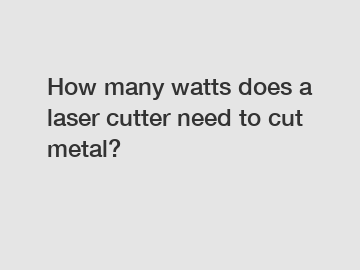How many watts does a laser cutter need to cut metal?
Laser cutting has become an increasingly popular technology for cutting a wide variety of materials, including metal. With its precision and versatility, laser cutting has revolutionized many industries, from manufacturing and automotive to aerospace and jewelry making. But when it comes to cutting metal with a laser cutter, one of the most common questions that comes up is: "How many watts does a laser cutter need to effectively cut through metal?".
The answer to this question is not as straightforward as one might think. The wattage of a laser cutter is just one of many factors that determine its ability to cut through metal. Other factors include the type of metal being cut, the thickness of the metal, the speed at which the laser cutter is operating, and the quality of the laser beam itself. However, wattage is still a crucial factor to consider when determining the capabilities of a laser cutter for cutting metal.
In general, the higher the wattage of a laser cutter, the more power it has to cut through thicker and denser materials. For cutting thin sheets of metal, a lower wattage laser cutter may be sufficient. However, for cutting thicker metal or more dense materials, a higher wattage laser cutter will be required.

So, how many watts does a laser cutter need to cut metal effectively? The answer depends on the type and thickness of the metal being cut. For cutting thin sheets of metal, such as aluminum or stainless steel, a laser cutter with 500-700 watts of power may be sufficient. However, for cutting thicker metals, such as steel or titanium, a laser cutter with 1000 watts or more may be necessary.
It's important to note that the wattage of a laser cutter is not the only factor to consider when cutting metal. The quality of the laser beam is also crucial. A high-quality laser beam will be able to cut through metal more efficiently and accurately than a lower-quality beam. Additionally, the speed at which the laser cutter is operating can also impact its ability to cut metal effectively. A laser cutter that is operating at a high speed may not be able to cut through metal as effectively as a slower machine.
When choosing a laser cutter for cutting metal, it's important to consider all of these factors and to consult with a professional in the field. An experienced and knowledgeable technician can help determine the best wattage and other specifications for a laser cutter based on the specific needs of the project.
In conclusion, the wattage of a laser cutter is an important factor to consider when cutting metal. Higher wattage laser cutters are generally more capable of cutting through thicker and denser metals, while lower wattage cutters are better suited for thinner materials. However, wattage is just one of many factors to consider when choosing a laser cutter for metal cutting. Factors such as the type of metal being cut, the thickness of the material, the quality of the laser beam, and the operating speed of the machine all play a role in determining the effectiveness of a laser cutter for cutting metal. For the best results, it's important to consult with a professional technician who can help determine the most suitable laser cutter for the job.
The company is the world’s best single flatform fiber laser cutting machine manufacturers, Three-chuck Fiber Laser Tube Cutting Machine, Single Platform Sheet & Tube Laser Cutting Machine supplier. We are your one-stop shop for all needs. Our staff are highly-specialized and will help you find the product you need.

Comments
0